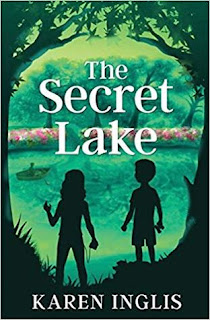The Ash House, by Angharad Walker (Chicken House, February 2, 2021), is a disturbing, gripping middle grade story of kids in a sanctuary, a sanctuary that is also a place of mortal peril. I'm not sure I "liked" it, but I did find it utterly absorbing, especially once I stopped trying to make sense of everything. This is impossible because many central questions, like "is this real?" aren't definitely answered. But, the strangeness aside, it is essentially a story of children surviving on their own trying to be good, and brave, and faithful to one another, and as such I found it profoundly moving.
It begins with an eleven year old kid, hospitalized for chronic, debilitating pain in his back, abruptly deposited at what he thinks must be some kind of convalescent home out in the country. There he's greeted by a resident boy, Dom (short for Freedom), who takes him under his wing and introduces him to the Ash House and its residents, all of whom are kids. He also gives the new kid a name--Solitude (Sol for short), a name as Nice as everyone else's. The concept of Niceness is the central precept of the Headmaster who founded the Ash House and brought the kids to live there.
But the beloved Headmaster has been gone for three years, and the kids are on their own, trying to keep things going the way he would have wanted, trying hard to live up to their names....
Sol is confused. It is a strange, strange place, with many peculiarities, like magical (?) drifting ash, and savage, unnatural beasts (?) prowling (to keep the children safe, or to keep them from leaving?). The other children can't remember anywhere else, and the longer Sol stays at Ash House, the more his old life fades.
I don't know if the Ash House is real, or some supernatural place, or what. But the kids who call it home love their Headmaster, who has taught them the precepts of Niceness, and loved and cared for them. They do not want to leave, although as they can't conceive of an outside world, this is something of a moot point. This is in itself pretty screwed up. But it gets worse.
Ash House isn't a convalescent home where Sol will be cured. Being sick there is the worst thing that could happen. Because then the Doctor comes, and no one is safe.
(the next bit is spoiler; I have to reveal a central fact about the story in order to talk about it).
The Doctor, who has no medical training or skill, basically plunges in to fix the sick kids and screws up. One kid has died. One is badly scarred. And now it's Sol's turn. But the real awfulness is that the Doctor is the same person as the Headmaster, ala Jeckel and Hyde. The kids have trained themselves to hide sickness and to never let the Doctor get them alone, trying to stay away from his interest until the Headmaster is back.
(end spoiler)
And so, whether or not the unbelievable bits are real, or real with a veneer of traumatized kid metaphor making them seem impossible, or utterly unreal, if is a fact that this is a group of kids in a abusive situation, and there has been so much gaslighting/brainwashing that they are trapped. But Sol, who was not raised there, is able to see that staying and hoping for the Headmaster to return isn't the answer.
It's an incredibly vivid story, the sort with lots and lots of description that is so well integrated into the story that you don't really register why your mind is making such clear pictures. It's a suspenseful mystery, as the reader, along with Sol, tries to figure out what's happening. It requires considerable suspension of disbelief, and readers who get cross if there's no closure of explanation will get very cross (there's a letter from the publisher at the beginning, in which she says she doesn't herself know what really happened). It's also the story of a group of children taking their survival into their own hands, and desperately trying to keep their community together, and I cared about them lots by the end of the story!
I can't think of any middle grade book much like it. I can, however, say that it is great for the 11-12 year old readers who are going to love
Nova Ren Suma's books when they are teenagers! (which should give those who have read A Room Away from the Wolves and The Walls Around Us an idea of what The Ash House feels like, only middle grade...)
disclaimer: review copy received from the publisher


.jpeg)
.jpeg)




















